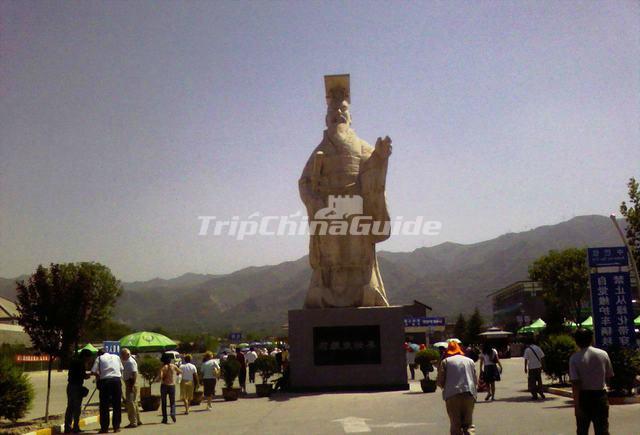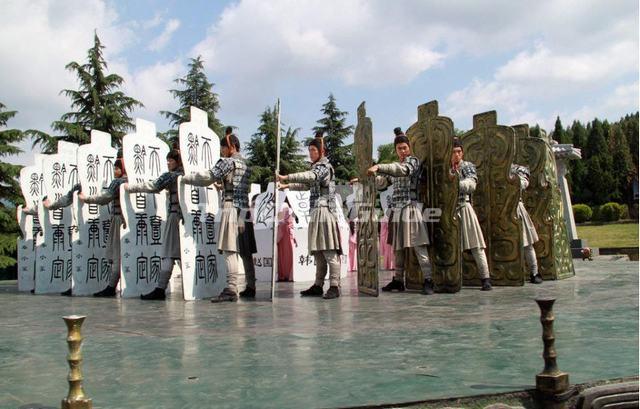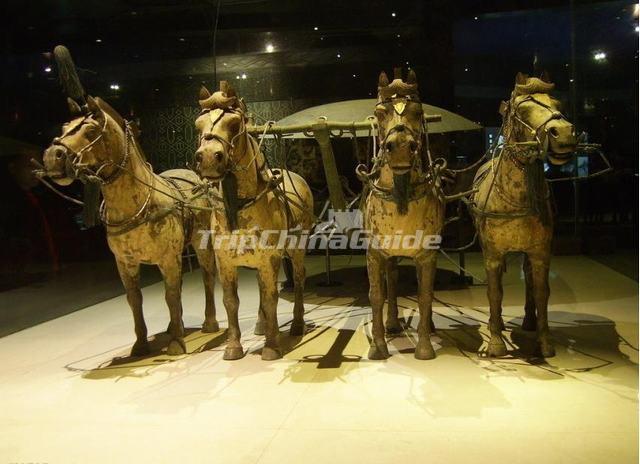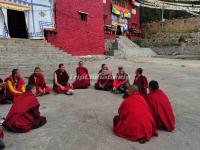Mausoleum of the First Qin Emperor
The first Qin Emperor (259 BC-210 BC), otherwise known as Emperor Ying Zheng, came to the throne of the Qin State at 13, and seized the helm of the state at 22. By 221 BC, when he was only 39 years old, he had annexed the six rival principalities and established the first feudal empire in Chinese history.
In the year 221 BC, after he unified the whole country, Ying Zheng styled himself the First Emperor, in the hope that the throne would be passed down to his descendants from one generation to another and that the hereditary system would be kept in working order forever. Each of the supreme rulers in later dynasties also called himself "emperor."
After he annexed the other six principalities, the First Qin Emperor abolished the enfeoffment system, and adopted the prefecture and county system instead. Dramatic steps were taken by his order to standardize the coinage, weights and measures, the legal codes, the axle length of carts, and the written scripts, because each of the seven states had kept its own system, which would cause much inconvenience to the whole populace. In an endeavor to deal with the harassment by the Hun aristocrats, the emperor ordered that the sections of the original Great Wall should be linked together. All these measures played an important role in strengthening the unification of the whole country and promoting the cultural and economic development. They exerted an everlasting influence upon the 2,000-year-long-feudal history of China.
In order to exercise thought control, the First Qin Emperor ordered that all books of various schools be burned except those on agriculture, divination, medicine and the Qin's history. Moreover, he also ordered 460 Confucian scholars be buried alive. As a result, almost all of the classics were destroyed.
After the unification of China, the First Qin Emperor became more arrogant and ambitious than ever because he believed that his contributions to the state were beyond compare, and he was even greater than the legendary Three Sovereigns and Five Supreme Lords. For the sake of his own pleasure, he had hundreds of thousands of conscripts build Afang Palace, which extended 50 kilometers from Xianyang (the capital) to Mount Lishan. Unfortunately, the Palace was put on fire by the insurrection army at the end of the Qin Dynasty. It was said that the big fire lasted for three months. We can well imagine how grand and magnificent his palace must have been.
As soon as he ascended the throne, Ying Zheng ordered that a magnificent mausoleum be built for him to ensure him a peaceful everlasting sleep. After he seized the power of the Qin in 221 BC, more than 700,000 conscripts were gathered from all parts of the country to work on his mausoleum. In fact, it took 37 years to complete the project.
The Mausoleum of the First Qin Emperor is located at the foot of Mount Lishan, about 35 kilometers east of Xi'an. It used to be surrounded by an inner wall and an outer one. It was originally 120 meters tall. But over 2, 000 years of erosion by wind and rain plus human destruction has reduced it to a height of 46 meters.
In Records of the Historian, Sima Qian recorded that the outer coffin was cast in molten copper, and the burial chamber was complete with palaces, halls and towers. Fine utensils, precious stones and other rarities were everywhere. Automatic crossbows were fixed to protect the tomb from robbery. The mercury lakes and waterways were built to present the Yellow River, the Yangtze River and even the vast ocean. The ceiling was decorated with pearls and gems to symbolize the celestial bodies, including the Sun and the Moon. The entire underground palace was presumably brightly lit by whale oil lamps forever.
After his funeral, his son, the Second Qin Emperor, decreed that his father's concubines without children should follow him to the grave. Someone said that the artisans responsible for the safety devices knew too much about the contents of the tomb. Therefore, once the coffin was placed in the burial chamber and the burial objects were all scaled up, the gate to the tomb was closed to imprison all those who had worked inside the tomb. Later, trees and grass were planted all over the mausoleum so that it would look like a natural hill.
The mausoleum of the First Qin Emperor is rich in cultural artifacts. Besides the terracotta army and the painted bronze chariots and horses, there are numerous Qin bricks and tiles of every description around the mausoleum. Experts have confirmed ever since 1982 that there is an intense mercury activity inside the mausoleum. We can therefore conclude that, what is described as "rivers and seas of mercury" in Records of the Historian is reliable and true.
According to the archaeological survey, the burial chamber has not been plundered or even broken into. With advances in technology, especially archaeological technology, all the underground treasures will come to light. It will unarguably create a sensation in the field of archaeology all over the world.
Ask Question
Recommended China Tour Packages
In this section
- Mount Hua
- Museum of Qin Terracotta Warrior...
- Big Wild Goose Pagoda
- Huaqing Pool
- Great Mosque of Xi'an
- Xi'an City Wall
- Mausoleum of the First Qin Emper...
- Bell Tower
- Shaanxi History Museum
- Forest of Stone Steles Museum
- Yangling Mausoleum
- Small Wild Goose Pagoda
- Xi'an Banpo Museum
- Drum Tower
- Xi'an Museum
Find China Tours
Cities and Attractions interested in















